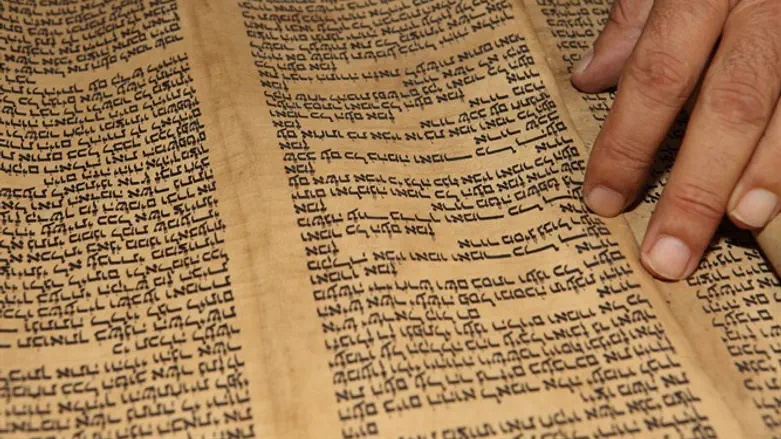
Just a few short weeks ago, on Shabbat, we read about Moshe: "He gazed, and there was a bush all aflame, yet the bush was not consumed.” (Parshat Shmot, Exodus, 3:2:) Moshe ponders how this is possible.
Perhaps this phenomenon can be understood as a metaphor. All through the ages, from time to time, we are set aflame but we, the Jewish people are not consumed.
Here is one such story, indeed our story; the miraculous resilience, survival and renewal of a Sefer Torah found in Bielsk Podalski, Poland.
Almlost thirty years ago, Moshe and Nili Weiler, our young cousins, led a group of Bnei Akiva students on a heritage tour of Poland. While there, at the suggestion of our late uncle. Moshe Alpert, they traveled to Bielsk, where our family is from, in search of any survivors. They found one, a Jew named Joseph Uzbitsky, elderly and in poor health; the only survivor remaining in Bielsk.
Joseph welcomed Moshe and Nili warmly. He remembered our family well, gave a tour of the remaining buildings that had once been occupied the flourishing and vibrant Jewish community. Over tea in his simple home and joined by his Christian wife, he shared what had befallen him.
The Germans entered Bielsk, on June 24, 1941. As they approached, Joseph decided to flee. He made his way to Russia, joined the Russian army and served for the duration of the war. For those remaining in Bielsk, including members of my family, the situation quickly turned ominous. Many Jews were herded into the synagogue called the Yefei Aynaim, which was set on fire. Others were forced into a ghetto and eventually sent to Treblinka.
After the war, Joseph returned to Bielsk. He walked the streets searching for family, friends, a familiar face. There were none. Of the almost 6,000 Jewish residents of Bielsk, none remained.
As he made his way through the town, he noticed a shoemaker’s shop. Sandals were displayed in the window and he noticed Hebrew writing on the sandals. He entered the shop and to his great dismay and though not a religious man in the least, he was horrified to see the shoemaker holding a Sefer Torah 
Joseph took all the severance pay he had received from the Russian army, gave it to the shoemaker and acquired the Torah. while cutting strips and soles for sandals. He called out and begged the shoemaker to stop but the shoemaker objected. “There is no leather to be had now and I need this leather for my work.” Joseph took all the severance pay he had received from the Russian army, gave it to the shoemaker and acquired the Torah.
while cutting strips and soles for sandals. He called out and begged the shoemaker to stop but the shoemaker objected. “There is no leather to be had now and I need this leather for my work.” Joseph took all the severance pay he had received from the Russian army, gave it to the shoemaker and acquired the Torah.
On close inspection, it was only half of a Sefer Torah. At the end of the remaining section, Parshat Shemini, the portion that tells us how the sons of Aaron were consumed by fire, there was evidence of a rip and burn marks. No Jewish community, no synagogue, what to do with this scroll?
Joseph wrapped the Torah carefully in cloth and buried it in the ground where it remained for almost 35 years.
Sitting with Moshe and Nili, Joseph suddenly recalled the Sefer Torah. He sent his wife out to the garden to dig it up and when she returned, he presented it to Moshe and Nili. “This Torah belongs in Israel, please take it with you.” Moshe agreed but how would he transport it? It was forbidden at that time, to remove artifacts from Poland and maybe this cut and burned remnant would be seen as one. The Bnei Akiva boys placed the Torah within the Torah they had brought with them for prayer. They reasoned that the Poles would not know if a Torah should have two handles or three. And so the Torah was brought to Israel.
In 2012, the Torah was restored by a gifted sofer, a scribe, Jamie Shear, who matched the style of the writing and also the parchment as best he could. A “Me'il” or Torah cover was ordered in green, reminiscent of the now flourishing Land of Israel. In bold letters of gold, appear verses from Psalm 102: 19-22..
A very emotional and joyous Hachnasat Sefer Torah (joyous ceremony held when a new Torah enters a shul) was held at the Bet Knesset Zayit Raanan on July 13, 2013, 10 Tamuz. In attendance, among members of the Efrat community, family and friends, were descendants of Bielsker, residents, including the granddaughter of the last rabbinic leader, Rabbi Moshe Aaron Ben Daat, Hy”d.
What had befallen this Sefer Torah? It came into being in the Exile of Poland, it was mutilated, it was burned, it was buried in the ground but then, it was lifted up, brought to Israel, restored to life. The Bielsker Sefer Torah is us. We will not be consumed, we will not be forgotten, we will not be abandoned; AM YISRAEL CHAI!
Lila Lowell grew up in NYC, earned an MSW and is a licensed certified clinical social worker (LCSW-C). She and her husband followed in their children's footsteps and made aliya from Montreal to Jerusalem 14 years ago. She is active in social welfare and in promoting Jewish Heritage and Zionist projects.
Lila and George Lowell merited the mitzva of seeing to the renewal of the Bielsk Sefer Torah. Afer consulting with the Rabbinate, they donated it to the shul in Efrat and arranged its joyous arrival there.